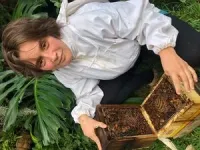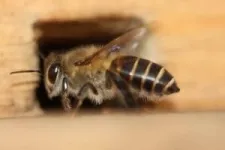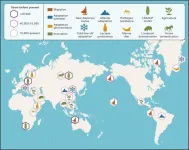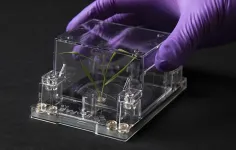(Press-News.org) Osteoarthritis (OA) is a debilitating joint disease which affects over 500 million people worldwide, with trends increasing as populations age. OA is caused by progressive, irreversible degeneration of joint cartilage, leading to pain, swelling and immobility in the affected joint. Current therapies focus on symptom relief but cannot restore degenerated cartilage.
A potentially alternative treatment is the regeneration of cartilage from stem cells. Importantly, not all types of stem cells can make cartilage and earlier clinical trials with mesenchymal stem or stromal cells (MSCs) obtained did not convincingly show that MSCs make new cartilage when given to OA patients. In search for the right type of stem cell for cartilage regeneration, Zhonghan Li and colleagues from Sichuan University, China, focused on so-called limb bud progenitor cells. The work was recently published in the journal Stem Cell Reports. During vertebrate embryogenesis, limb bud progenitor cells give rise to limb cartilage, bone, and tendon, suggesting that this type of stem cell has a naturally high intrinsic capacity to make cartilage.
To test this hypothesis, the researchers used genetic tools to isolate limb bud progenitors from developing mouse embryos. Remarkably, after injection into knee joints of mice with OA, the limb bud progenitor cells efficiently generated new cartilage whereas MSCs given to a separate group of mice failed to do so. Despite these encouraging results, limb bud progenitors are not readily obtainable from humans. To overcome this, Li and colleagues turned towards human pluripotent stem cells (hPSCs), which are immature stem cells that can be grown to high numbers in the lab. After extensive protocol optimization, the researchers indeed obtained hPSCs-derived limb bud progenitors which closely resembled embryonic limb bud progenitors according to gene and protein expression. Encouragingly, like their embryonic counterparts, hPSC-derived limb bud progenitors made new cartilage when transplanted into the knees of OA mice.
These findings set the stage for a potential cartilage replacement therapy for patients with OA, but further studies in animal models are required to confirm and replicate these findings. If such a treatment advances to the clinic it will need to pass proper regulatory review.
END
New type of stem cells contains potential for knee cartilage regeneration in arthritic mice
2024-02-29
ELSE PRESS RELEASES FROM THIS DATE:
Becoming human: An ancient genome perspective
2024-02-29
Writing a commentary in the 50th anniversary issue of Cell, FU Qiaomei and E. Andrew Bennett, both of the Institute of Vertebrate Paleontology and Paleoanthropology (IVPP) of the Chinese Academy of Sciences, explored the contribution of paleogenomics to our understanding of the evolution of modern humans.
Given her numerous contributions to the field of human evolution through the analysis of both archaic and early modern human genomes, Prof. FU was invited by the journal Cell to write a commentary reviewing what we have learned about the evolution ...
Extreme weather events tied to increased mortality and emergency department activity
2024-02-29
Climate change is increasing the frequency and intensity of severe weather events, which may particularly endanger vulnerable populations such as the elderly. Researchers from Mass General Brigham and colleagues examined how weather disasters between 2011 and 2016 influenced healthcare delivery and mortality among Medicare beneficiaries in affected counties, finding that one week after major weather events, emergency department (ED) use and mortality remained elevated by 1.22% and 1.4%, respectively, from pre-disaster ...
Bottlenecks and beehives: how an invasive bee colony defied genetic expectations
2024-02-29
For more than a decade, invasive Asian honeybees have defied evolutionary expectations and established a thriving population in North Queensland, much to the annoyance of the honey industry and biosecurity officials.
Research published today in Current Biology has shown the species, Apis cerana, has overcome what is known as a genetic bottleneck to grow from a single swarm into a population of more than 10,000 colonies over a 10,000 square kilometre area – which is about the size of Greater Sydney.
Co-lead author Dr Rosalyn Gloag from the University of Sydney School of Life and Environmental Sciences said: “Our study of this bee population shows that some species can ...
Climate: 2023 – 24 El Niño likely to cause record-breaking average temperatures in some areas
2024-02-29
Several areas of the globe — including the Bay of Bengal, the Philippines, and the Caribbean Sea — are likely to experience record-breaking average surface air temperatures in the year period up to June 2024 as a result of the ongoing El Niño phenomenon. The modelling results, published in Scientific Reports, also suggest that there is an estimated 90 percent chance of record-breaking global mean surface temperatures occurring over the same period under a moderate or strong El Niño scenario.
The El Niño-Southern Oscillation, centred ...
Disparities in patient portal use among adults with chronic conditions
2024-02-29
About The Study: This study of 536 participants identified changes in patient portal use over time and highlighted populations that had lower access to health information. The COVID-19 pandemic was associated with an increase in portal use. Sociodemographic disparities by sex and age were reduced, although disparities by health literacy widened. A brief validated health literacy measure may serve as a useful digital literacy screening tool to identify patients who need further support.
Authors: Esther Yoon, Ph.D., M.P.H., M.S., of Northwestern University in Chicago, is the corresponding ...
Factors associated with racial and ethnic disparities in locally advanced rectal cancer outcomes
2024-02-29
About The Study: The findings of this study of 34,500 patients suggest that racial and ethnic disparities in locally advanced rectal cancer treatment outcomes may be multifactorial, with an independent association with non-Hispanic Black race, suggesting unidentified biological variables or social determinants of health that warrant exploration.
Authors: Sanjeevani Arora, Ph.D., and Shannon M. Lynch, Ph.D., M.P.H., of the Fox Chase Cancer Center in Philadelphia, are the corresponding authors.
To access the embargoed study: Visit our For The Media website at this link https://media.jamanetwork.com/
(doi:10.1001/jamanetworkopen.2024.0044)
Editor’s ...
CZI announces multi-institutional collaborations for tech to better understand cells
2024-02-29
Today, the Chan Zuckerberg Initiative (CZI) announced four multi-year grants that will bring together regional labs in California, the Mid-Atlantic, and the Research Triangle in North Carolina to explore the frontiers of genomics, cell biology, and synthetic biology by developing new measurement technologies. These projects will focus on developing technologies to engineer cell and tissue models, exploring cellular responses to genetic and environmental stressors, understanding RNA's role in metabolism, and more.
“To unravel the mysteries of the cell, we need new technologies, and the Exploratory Cell Networks grants support early-stage ...
Researchers uncover key therapeutic target involved in diabetic atherosclerosis
2024-02-29
Diabetes accelerates the development of atherosclerosis, increasing the incidence of cardiovascular events. In atherosclerosis, immune cells called macrophages release molecules such as chemokines and cytokines, causing inflammation and leading to arterial plaque formation. However, significant gaps persist in understanding the exact molecular mechanisms controlling this increased inflammatory response in individuals with diabetes. In a new, preclinical study, researchers from Brigham and Women’s Hospital, a founding member of the Mass General Brigham healthcare system, identified a long non-coding RNA (lncRNA) sequence that could help them unravel the ...
Scripps Research scientists reveal how first cells could have formed on Earth
2024-02-29
LA JOLLA, CA—Roughly 4 billion years ago, Earth was developing conditions suitable for life. Origin-of-life scientists often wonder if the type of chemistry found on the early Earth was similar to what life requires today. They know that spherical collections of fats, called protocells, were the precursor to cells during this emergence of life. But how did simple protocells first arise and diversify to eventually lead to life on Earth?
Now, Scripps Research scientists have discovered one plausible pathway for how protocells may have first formed and chemically ...
EcoFABs could lead to better bioenergy crops
2024-02-29
– By Will Ferguson
A greater understanding of how plants and microbes work together to store vast amounts of atmospheric carbon in the soil will help in the design of better bioenergy crops for the fight against climate change.
Deciphering the mechanics of this mutually beneficial relationship is challenging, however, as conditions in nature are extremely difficult for scientists to replicate in the laboratory. To address this challenge, researchers at Lawrence Berkeley National Laboratory (Berkeley Lab) created fabricated ecosystems or EcoFABs.
In a new paper in Science Advances, they ...






